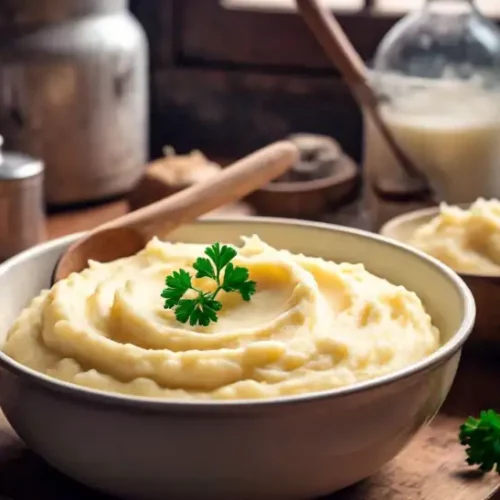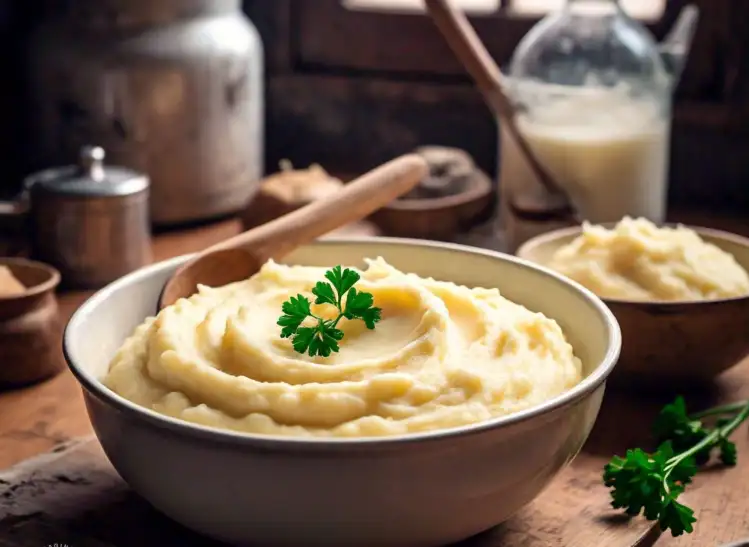Simmering potatoes in milk instead of water offers a unique twist to a classic dish. This method infuses the potatoes with dairy richness, enhances their creamy texture, and preserves their natural starch for a smoother consistency.
Unlike traditional water-boiled methods, milk-simmering retains and amplifies flavor without the need for heavy cream. It also simplifies preparation by combining cooking and flavor infusion in a single step.
The result is rich, silky mashed potatoes that are easy to prepare and perfect for any occasion, whether as a comforting side dish or a holiday centerpiece.
Master the technique of cooking potatoes in milk for the creamiest mashed potatoes you’ll ever taste.
Why Milk-Simmered Mashed Potatoes Work
- Enhanced Creaminess
- Cooking potatoes in milk infuses them with dairy’s natural richness. Unlike water, milk contributes to the final dish’s flavor and texture, creating a smooth, luxurious result without needing heavy cream.
- Starch Retention
- By skipping the rinsing or soaking steps, the starch in the potatoes is preserved. Starch is critical for achieving that silky, cohesive texture.
- Yukon Gold Advantage
- Yukon Gold potatoes strike the perfect balance between starchiness and moisture, making them ideal for creamy mashed potatoes. Russets, though fluffier, can become too mealy for this technique.
- Whole Milk is Key
- Whole milk prevents curdling during the simmering process. Low-fat milk lacks the fat content necessary to maintain a stable emulsion.

Recipe: Milk-Simmered Mashed Potatoes
Ingredients
- 4 pounds Yukon Gold potatoes peeled and cut into 1/2-inch chunks
- 5 cups whole milk plus more as needed
- 8 tablespoons salted butter 1 stick, cut into pieces
- Kosher salt and freshly ground black pepper
Instructions
Combine Ingredients:
- In a large saucepan or Dutch oven, add the potatoes, milk, and 2 teaspoons of salt. Stir gently to combine.
Simmer Potatoes:
- Bring the mixture to a simmer over medium heat, then reduce to low. Cook uncovered, stirring occasionally, until the potatoes start to break apart and most of the milk is absorbed (40-50 minutes).
Mash the Potatoes:
- Remove from heat. Add the butter and mash the potatoes to your desired consistency using a potato masher. For an ultra-smooth texture, use a ricer or food mill.
Adjust Consistency:
- If needed, add additional milk to achieve your preferred texture. Season with salt and pepper to taste.
Serve and Enjoy:
- Serve immediately as a rich, comforting side dish.
Pro Tips and Variations
- Add Garlic or Herbs: For added flavor, simmer the potatoes with whole garlic cloves or fresh thyme sprigs.
- Cheesy Twist: Fold in grated Parmesan or sharp cheddar after mashing.
- For Fluffier Potatoes: Use Russet potatoes and rinse them before cooking to remove excess starch, as this minimizes gumminess.
Nutritional Insights
Milk-simmered mashed potatoes are lower in fat compared to versions made with heavy cream while still delivering rich flavor. Using whole milk and butter strikes a balance between indulgence and health-consciousness.
Science Behind the Technique
- Role of Starch: Starch released during cooking helps bind the potatoes, creating a creamy texture. Excessive starch release (e.g., from over-mashing) can lead to a gluey consistency.
- Avoid Curdling: Whole milk’s fat content stabilizes it during simmering. Low-fat milk may separate under heat, compromising texture and flavor.
- No Rinsing Rule: Washing cut potatoes removes surface starch necessary for creaminess. By skipping this step, the final dish remains cohesive and smooth.
Conclusion
Milk-simmered mashed potatoes offer a rich, creamy texture without the need for heavy cream. By following this technique, you’ll achieve a dish that’s both decadent and easy to prepare. Whether as a holiday side or a weeknight comfort food, these mashed potatoes are sure to impress.

